Seat Altea XL 2015 Owner's Manual
Manufacturer: SEAT, Model Year: 2015, Model line: Altea XL, Model: Seat Altea XL 2015Pages: 236, PDF Size: 4.23 MB
Page 201 of 236
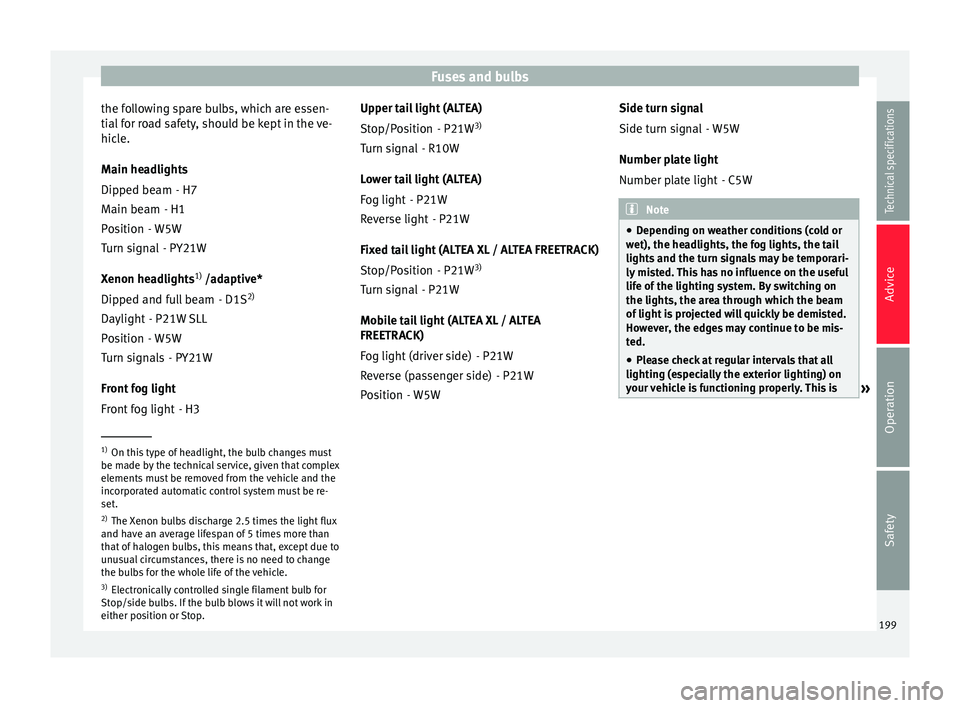
Fuses and bulbs
the following spare bulbs, which are essen-
tial for road safety, should be kept in the ve-
hicle.
Main headlights - H7
- H1
- W5W - PY21W
Xenon headlights 1)
/adaptive*
- D1S 2)
- P21W SLL
- W5W - PY21W
Front fog light - H3
Dipped beam
Main beam
Position
Turn signal
Dipped and full beam
Daylight
Position
Turn signals
Front fog light Upper tail light (ALTEA)
- P21W3)
- R10W
Lower tail light (ALTEA) - P21W- P21W
Fixed tail light (ALTEA XL / ALTEA FREETRACK) - P21W3)
- P21W
Mobile tail light (ALTEA XL / ALTEA
FREETRACK) - P21W- P21W
- W5W
Stop/Position
Turn signal
Fog light
Reverse light
Stop/Position
Turn signal
Fog light (driver side)
Reverse (passenger side)
Position Side turn signal
- W5W
Number plate light - C5W Note
● Depending on weather conditions (cold or
wet), the headlights, the fog lights, the tail
lights and the turn signals may be temporari-
ly misted. This has no influence on the useful
life of the lighting system. By switching on
the lights, the area through which the beam
of light is projected will quickly be demisted.
However, the edges may continue to be mis-
ted.
● Please check at regular intervals that all
lighting (especially the exterior lighting) on
your vehicle is functioning properly. This is » Side turn signal
Number plate light
1)
On this type of headlight, the bulb changes must
be made by the technical service, given that complex
elements must be removed from the vehicle and the
incorporated automatic control system must be re-
set.
2) The Xenon bulbs discharge 2.5 times the light flux
and have an average lifespan of 5 times more than
that of halogen bulbs, this means that, except due to
unusual circumstances, there is no need to change
the bulbs for the whole life of the vehicle.
3) Electronically controlled single filament bulb for
Stop/side bulbs. If the bulb blows it will not work in
either position or Stop. 199Technical specifications
Advice
Operation
Safety
Page 202 of 236
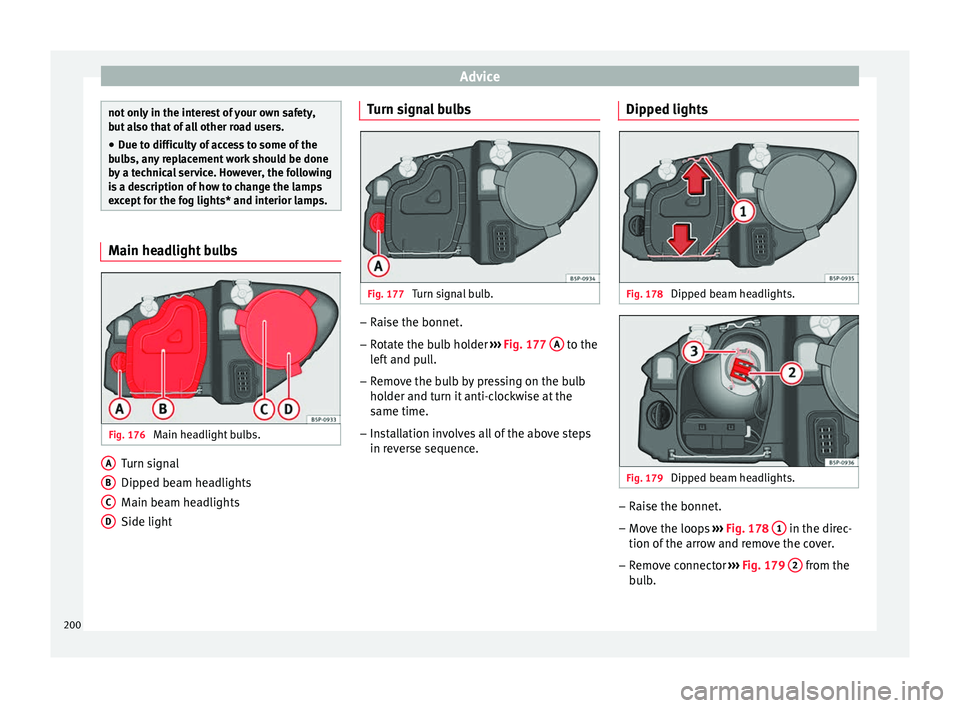
Advice
not only in the interest of your own safety,
but also that of all other road users.
● Due to difficulty of access to some of the
bulbs, any replacement work should be done
by a technical service. However, the following
is a description of how to change the lamps
except for the fog lights* and interior lamps. Main headlight bulbs
Fig. 176
Main headlight bulbs. Turn signal
Dipped beam headlights
Main beam headlights
Side light
A B
C
D Turn signal bulbs
Fig. 177
Turn signal bulb. –
Raise the bonnet.
– Rotate the bulb holder ››› Fig. 177 A to the
left and pull.
– Remove the bulb by pressing on the bulb
holder and turn it anti-clockwise at the
same time.
– Installation involves all of the above steps
in reverse sequence. Dipped lights Fig. 178
Dipped beam headlights. Fig. 179
Dipped beam headlights. –
Raise the bonnet.
– Move the loops ››› Fig. 178 1 in the direc-
tion of the arrow and remove the cover.
– Remove connector ››› Fig. 179 2 from the
bulb.
200
Page 203 of 236
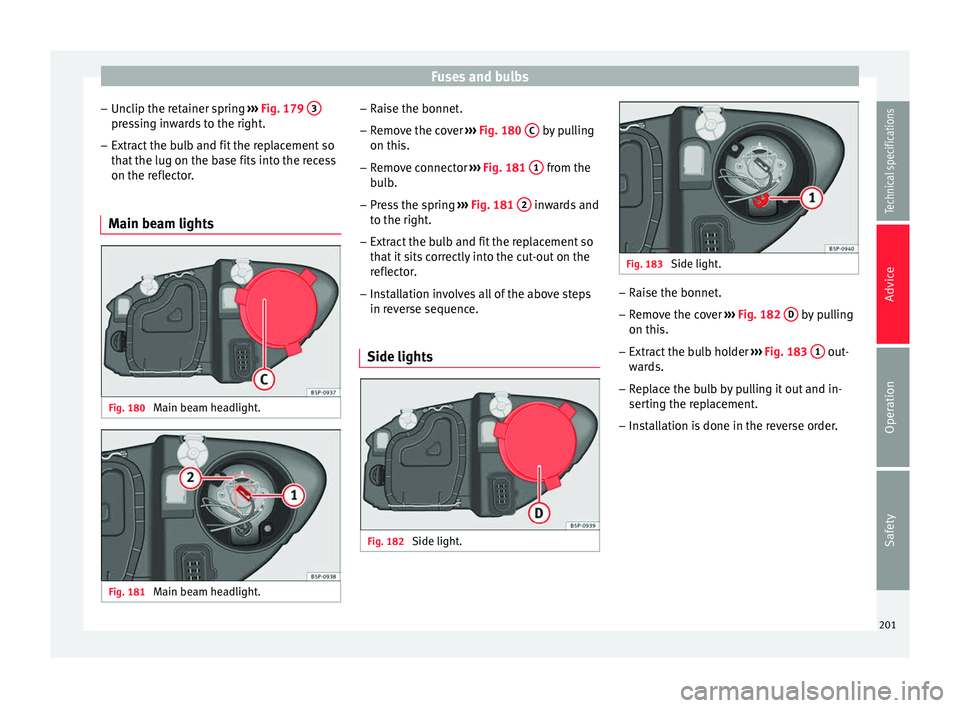
Fuses and bulbs
– Unclip the retainer spring ››› Fig. 179 3 pressing inwards to the right.
– Extract the bulb and fit the replacement so
that the lug on the base fits into the recess
on the reflector.
Main beam lights Fig. 180
Main beam headlight. Fig. 181
Main beam headlight. –
Raise the bonnet.
– Remove the cover ››› Fig. 180 C by pulling
on this.
– Remove connector ››› Fig. 181 1 from the
bulb.
– Press the spring ››› Fig. 181 2 inwards and
to the right.
– Extract the bulb and fit the replacement so
that it sits correctly into the cut-out on the
reflector.
– Installation involves all of the above steps
in reverse sequence.
Side lights Fig. 182
Side light. Fig. 183
Side light. –
Raise the bonnet.
– Remove the cover ››› Fig. 182 D by pulling
on this.
– Extract the bulb holder ››› Fig. 183 1 out-
wards.
– Replace the bulb by pulling it out and in-
serting the replacement.
– Installation is done in the reverse order.
201Technical specifications
Advice
Operation
Safety
Page 204 of 236

Advice
Side lights/ brake lights 3 Applies to the model: ALTEA
Fig. 184
Side lights and brake lights. Fig. 185
Side lights and brake lights. –
Open the rear lid.
– Remove the bolts ››› Fig. 184 A .
– Remove the cover of the luggage compart-
ment lateral panel. –
Unscrew the plastic fitting ››› Fig. 185 B securing the tail light. Inserting a screw-
driver under the plastic fitting may help to
loosen it.
– Partially remove the tail light from its cas-
ing taking care not to pull on the cable.
– Remove the bulb holder connector.
– Unscrew the bolts ››› Fig. 186 C from the
bulb holder and pull on this.
– Press on the bulb and rotate to the left then
fit the replacement.
– To refit follow the steps in reverse order,
taking special care when fitting the bulb
holder. The metal contacts of the bulb hold-
er ends should be correctly fitted with re-
spect to the rear light contacts. Turn signal light 3 Applies to the model: ALTEA
Fig. 186
Turn signal light. Fig. 187
Turn signal light. –
Remove the lamp from its housing
››› page 202.
– Unscrew the bolts ››› Fig. 186 C from the
bulb holder and pull on this.
202
Page 205 of 236

Fuses and bulbs
– Pull out the turn signal bulb holder using a
screw driver in the direction of the arrow
››› Fig. 187 .
– Fit the r
eplacement bulb by pressing it
down and rotating to the left.
– Installation involves all of the above steps
in reverse sequence.
Reverse light/rear fog light 3 Applies to the model: ALTEA
Fig. 188
Lamp on interior side of bumper. –
Rotate the bulb holder to the left and re-
move it in the direction of the arrow
››› Fig. 188.
– Replace the bulb by pressing on it and ro-
tating at the same time to the left Turn signal, side and brake lights on
the body 3 Applies to the model: ALTEA XL/ALTEA FREETRACK
Fig. 189
Lights on the vehicle body. Fig. 190
Lights on the vehicle body. –
Open the cover of the luggage compart-
ment side panel ››› Fig. 189 .
– Turn the b
ulb holder to the left ››› Fig. 190. –
Remove the blown bulb and change it for a
new one.
– To refit follow the steps in reverse order,
taking special care when fitting the bulb
holder.
203
Technical specifications
Advice
Operation
Safety
Page 206 of 236

Advice
Position light, fog light and reverse
light on the rear lid 3 Applies to the model: ALTEA XL/ALTEA FREETRACK
Fig. 191
Lights on the boot. Fig. 192
Side light. Side light
A–
Open the rear lid.
– Pull the cover off. –
Take the lampholder out pressing on the
securing pins and extract it outwards.
– Remove the blown bulb and replace it with
another.
– To refit follow the steps in reverse order,
taking special care when fitting the bulb
holder.
Fog light and reverse lights B –
Open the rear lid.
– Pull the cover off.
– Turn the bulb holder to the left.
– Remove the blown bulb and replace it with
another.
– Installation involves all of the above steps
in reverse sequence. Side turn signals Fig. 193
Side turn signal. –
Press the turn signal to the left or to the
right to remove the bulb.
– Remove the bulb holder from the turn sig-
nal.
– Remove the failed glass bulb and replace
with a new bulb.
– Insert the bulb holder in the turn signal
guide until it clicks into place.
– First place the turn signal in the opening in
the bodywork, fixing the tabs ››› Fig. 193 ,
arr o
w 1 .
– Insert the bulb as shown by the arrow 2 ›››
Fig. 193.
204
Page 207 of 236

Fuses and bulbs
Luggage compartment lights Fig. 194
Boot light. Fig. 195
Boot light. –
Extract the bulb by pressing on its inside
edge -arrow- using the flat side of a screw-
driver ››› Fig. 194 .
– Pr e
ss the bulb sideways and remove it from
its housing ››› Fig. 195. Re
gistration light 3 Applies to the model: ALTEA
Fig. 196
Number plate light. Fig. 197
Number plate light. –
Remove the bulb, carefully using the flat
side of a screwdriver as a lever inserted in
the crack as shown by the arrow
››› Fig. 196 .
– Remo
ve the bulb, moving it outward and in
the direction of the arrow ››› Fig. 197. Re
gistration light 3
Applies to the model: ALTEA XL/ALTEA FREETRACK Fig. 198
Number plate light. Fig. 199
Number plate light. –
Unscrew the screws to remove the bulb
››› Fig. 198 .
– Remo
ve the bulb, moving it outward and in
the direction of the arrow ››› Fig. 199.
– Ins
tallation involves all of the above steps
in reverse sequence. 205
Technical specifications
Advice
Operation
Safety
Page 208 of 236
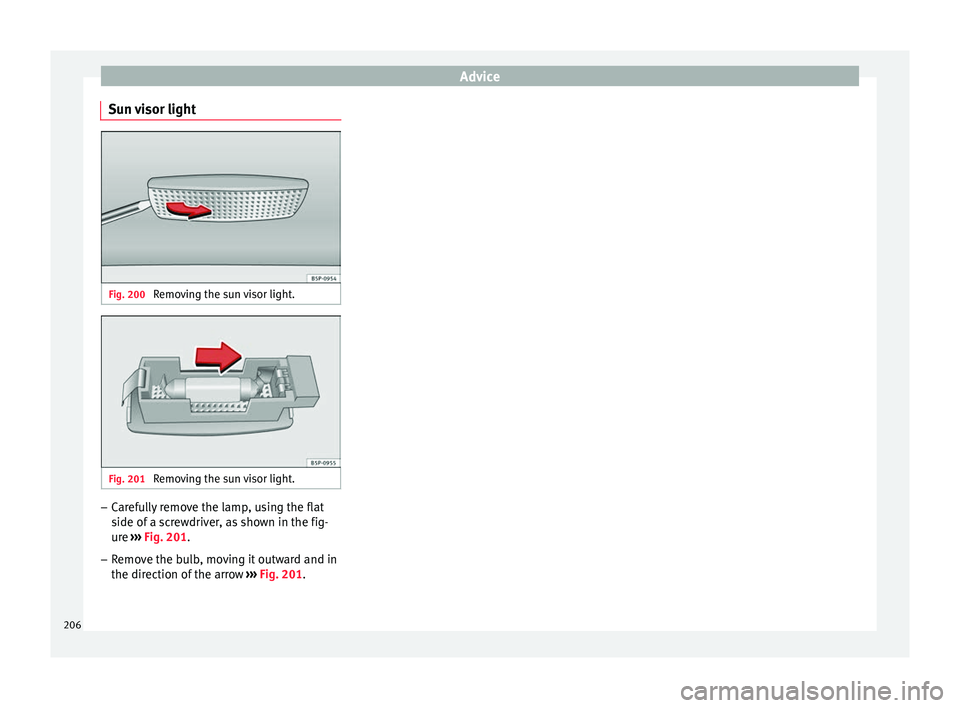
Advice
Sun visor light Fig. 200
Removing the sun visor light. Fig. 201
Removing the sun visor light. –
Carefully remove the lamp, using the flat
side of a screwdriver, as shown in the fig-
ure ››› Fig. 201 .
– Remo
ve the bulb, moving it outward and in
the direction of the arrow ››› Fig. 201.
206
Page 209 of 236

Technical features
Technical specifications
Technical features
Important information Important The information in the vehicle documentation
always takes precedence over the informa-
tion in this Instruction Manual.
All technical specifications provided in this
documentation are valid for the standard
model in Spain. The vehicle data card inclu-
ded in the Maintenance Programme or the
vehicle registration documents shows which
engine is installed in the vehicle.
The figures may be different depending
whether additional equipment is fitted, for
different models, for special vehicles and for
other countries.
Abbreviations used in the Technical
Specifications sectionAb-
brevia- tionMeaning
kWKilowatt, engine power measurement.
PSPferdestärke (horsepower), formerly used to
denote engine power.
Ab-
brevia- tionMeaning
rpmRevolutions per minute - engine speed.
NmNewton metres, unit of engine torque.
litresper
100 kmFuel consumption in litres per 100 km (70
miles).
g/kmCarbon dioxide emissions in grams per km
(mile) travelled.
CO 2Carbon dioxide
CNCetane number, indication of the diesel com-
bustion power.
RONResearch octane number, indication of the
knock resistance of petrol. 207
Technical specifications
Advice
Operation
Safety
Page 210 of 236
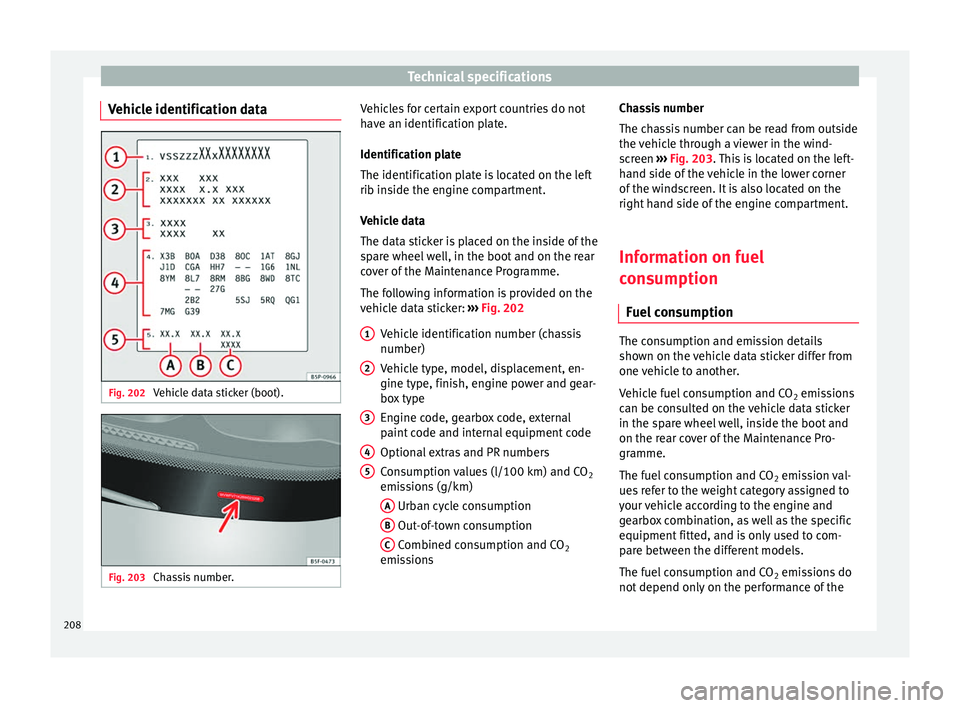
Technical specifications
Vehicle identification data Fig. 202
Vehicle data sticker (boot). Fig. 203
Chassis number. Vehicles for certain export countries do not
have an identification plate.
Identification plate
The identification plate is located on the left
rib inside the engine compartment.
Vehicle data
The data sticker is placed on the inside of the
spare wheel well, in the boot and on the rear
cover of the Maintenance Programme.
The following information is provided on the
vehicle data sticker:
››› Fig. 202
Vehicle identification number (chassis
number)
Vehicle type, model, displacement, en-
gine type, finish, engine power and gear-
box type
Engine code, gearbox code, external
paint code and internal equipment code
Optional extras and PR numbers
Consumption values (l/100 km) and CO 2
emissions (g/km)
A Urban cycle consumption
B Out-of-town consumption
C Combined consumption and CO
2
emissions
1 2
3
4
5 Chassis number
The chassis number can be read from outside
the vehicle through a viewer in the wind-
screen
››› Fig. 203 . This is located on the left-
h and s
ide of the vehicle in the lower corner
of the windscreen. It is also located on the
right hand side of the engine compartment.
Information on fuel
consumption
Fuel consumption The consumption and emission details
shown on the vehicle data sticker differ from
one vehicle to another.
Vehicle fuel consumption and CO
2 emissions
can be consulted on the vehicle data sticker
in the spare wheel well, inside the boot and
on the rear cover of the Maintenance Pro-
gramme.
The fuel consumption and CO 2 emission val-
ues refer to the weight category assigned to
your vehicle according to the engine and
gearbox combination, as well as the specific
equipment fitted, and is only used to com-
pare between the different models.
The fuel consumption and CO 2 emissions do
not depend only on the performance of the
208